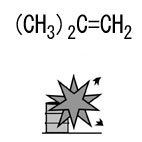| Case Name |
Explosion of an air heater of a boiler at an agricultural chemical manufacturing plant |
| Pictograph |

|
| Date |
February 10, 1997 |
| Place |
Oita, Oita, Japan |
| Location |
Pesticide factory |
| Overview |
Exhaust gas was mixed with combustion air during operation of the boiler to treat a bad smell. Accumulated isobutene in piping flowed into the boiler on starting a plant. Combustion became imbalanced, unburned gas flowed into the high-temperature side of the air heater, and it exploded. |
| Incident |
An air heater which heats combustion air for a steam boiler exploded when an agricultural chemicals manufacturing plant started operation. The cause was contamination with combustible gas of the combustion air. It was mixed by poor work by the manufacturing section.
Air heater: A heat exchanger for combustion air and boiler exhaust gas, which is prepared for recovering heat from boiler exhaust gas. |
| Processing |
Waste and disposal |
| Substance |
Isobutene, Fig2 |
| Type of Accident |
Explosion |
| Sequence |
09:00 on February 10th, 1997. The steam boiler was in usual operation. The 3rd manufacturing section started operation. At that time, exhaust gas from the 8th and the 9th manufacturing sections had already been burned by the boiler.
09:40. A valve in piping for raw-material isobutene was opened at the 3rd manufacturing section. An alarm indicating an oxygen concentration fall in the exhaust gas of the boiler sounded at almost the same time. Although it did not result in an alarm, the pressure and the steam flow rate also increased. Then, the amount of fuel supply was decreased by a board operation.
09:45. The steam flow rate did not decrease yet. The amount of fuel supply was decreased more. As combustion of the boiler started fluctuation, the fuel supply valve was closed to stop operation.
09:50. The air heater exploded.
09:55. A bad smell was noticed at the manufacturing section and the valve of piping to a boiler was closed by the manufacturing section.
10:15. Fuel supply was stopped. |
| Cause |
Exhaust gas of the manufacturing section was burned by the boiler to treat a bad smell. Exhaust gas was mixed with air and sent to the boiler via the air heater. The manual valve, which was connected to both process piping including isobutene and exhaust gas piping to the air heater of the boiler, had not been closed completely on starting the manufacturing section. Therefore, the isobutene contaminated the air for boiler combustion. The connecting piping was not used for combustion treating by the boiler at that time, but it was still connected. |
| Response |
The boiler was stopped. |
| Countermeasures |
The structure should be changed so that flammable gas cannot flow into equipment. |
| Knowledge Comment |
The boiler is used for treating not only a bad smell but also a flammable gas in the combustion process of exhaust gas. In the case of a general boiler, if fuel is stopped, the fire is extinguished and only air is discharged. However, in the case of a boiler for combustion treating, when the fire is extinguished, exhaust gas that should be treated is discharged. Therefore, when fuel supply is stopped, inflow of exhaust gas to be treated must be stopped before extinguishing the fire.
Moreover, as valves leak due to human factors and equipment factors, the reliability of cutoff with only one valve is not so high as expected. |
| Background |
The connecting valve was left as it was even after the directions of equipment and piping were changed. The piping was isolated by only one manual valve. It seems that recognition that a valve could leak is insufficient.
Although valve closing was checked as specified in the operation standard, a slight opening was not noticed as it was a manual valve. |
| Reason for Adding to DB |
Example of explosion caused due to hazards of treating an exhaust gas to remove a bad smell |
| Scenario |
| Primary Scenario
|
Poor Value Perception, Poor Safety Awareness, Inadequate Risk Recognition, Carelessness, Insufficient Precaution, Carelessness of Operator, Insufficient Analysis or Research, Insufficient Practice, Lack of Imagination, Planning and Design, Poor Planning, Poor Design, Incorrect Reaction, Poor Communication, No Communication, Malfunction, Poor Hardware, Valve Seat Leak, Secondary Damage, External Damage, Explosion, Loss to Organization, Economic Loss, Manetary Damage 15 million yen
|
|
| Sources |
High Pressure Gas Safety Inst. of Japan, High-pressure gas protection overview. 1998 edition, pp.160-161 (1998).
Major cases of accidents, 1997, Industry and Safety, Vol.14, No.36, p.6 (1998)
Res. Inst. of Industrial Safety material. (closed).
|
| Physical Damage |
Damage to outer walls of a heater |
| Financial Cost |
¥ 15 million. (Fire and Disaster Management Agency). |
| Multimedia Files |
Fig2.Chemical formula
|
| Field |
Chemicals and Plants
|
| Author |
ITAGAKI, Haruhiko (Japan National Institute of Occupational Safety and Health)
TAMURA, Masamitsu (Center for Risk Management and Safety Sciences, Yokohama National University)
|
|